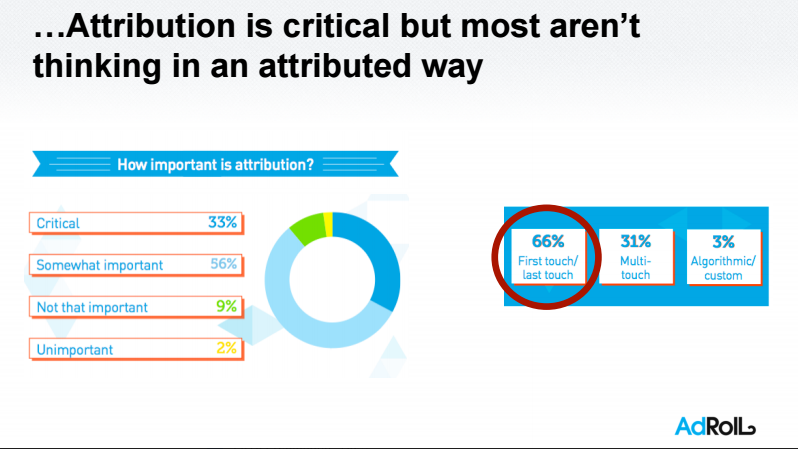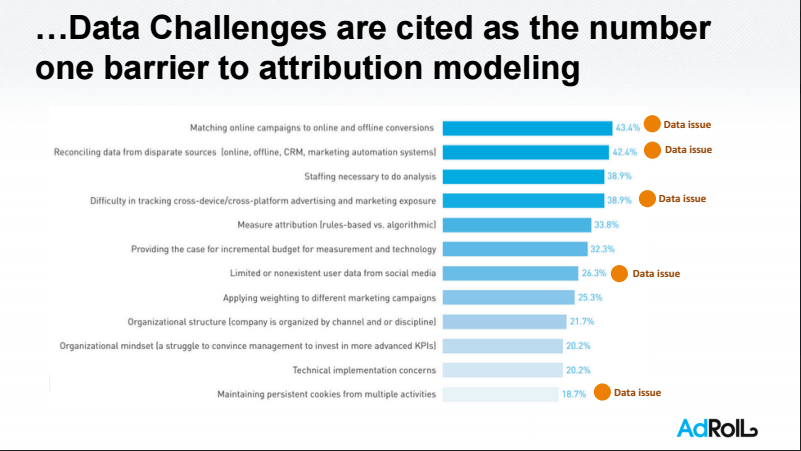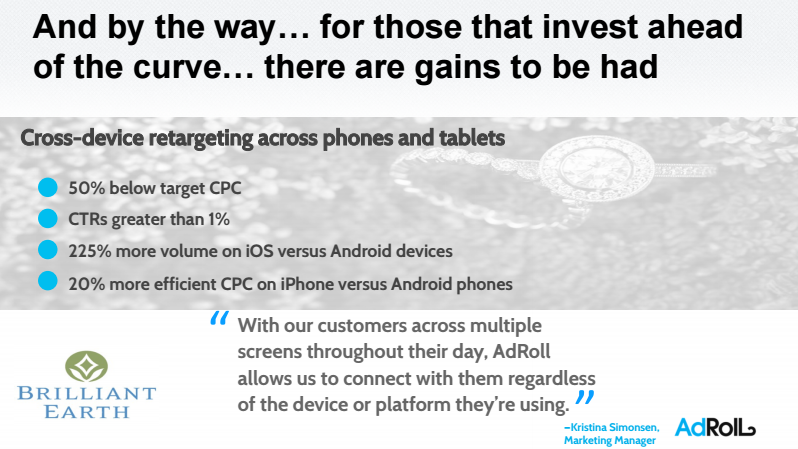How 'Last-Click' Attribution is Persisting in the Cross-Screen Era
by on 14th Apr 2015 in News


'Last-click' remains the prevalent method for advertisers to reward third parties on their media plan, despite mounting voices to the contrary. ExchangeWire explores how tracking campaign performance remains largely unsatisfactory to many in the era of cross-screen campaigns.
The latest IAB ad spend figures are just the most recent in a long line of empirical studies demonstrating how the emergence of consumer mobile media consumption means we are well and truly in the cross-screen era.
Mobile now accounts for almost a quarter (23%) of all digital ad spend, and up to 56% of all spend on paid-for social media, valuing the industry at almost £1bn a year (with total digital ad spend amounting to £7.2bn per year).
However, while it's evident that ad campaigns are increasingly cross-screen, campaign assessment and analytics are stuck in a more linear mindset.
Speaking at the recent IAB RTA conference, Michael Bertaut, AdRoll, managing director, EMEA, explained how most advertisers' attribution methods remain stuck in a linear mindset.
Citing AdRoll's State of the Industry Report*, based on the company's findings from 2014, he highlighted how attribution as one of the three foremost areas to be addressed among the advertising industry.
However, the study demonstrates how most advertisers use a 'single-touch attribution model' (where commission is awarded to a single party, despite there being multiple parties being on a media plan), with over two-thirds of respondents using the model (see graphic below).
Speaking with ExchangeWire, Bertaut said: "I'm the first to acknowledge that mobile is not yet fully baked [when it comes to fulfilling its potential as an advertising medium].
"This is due mainly to the bad experiences with things like retargeting on mobile.”
Bertaut went on to highlight how many of the "pain points" around mobile come down to "data challenges", pointing to further findings from AdRoll's report.
The figures state that 38.9% of participants cited "difficulty in tracking cross-device advertising" as just one of the reasons for continuing with such a linear method of campaign assessment.
A further 42.4% cited difficulties in reconciling data from "disparate sources of online, offline, CRM and marketing automation systems" as significant barriers to developing more sophisticated attribution modelling."
Persisting with such a myopic approach in an era when users are consuming media across different screens in a seamless manner means advertisers are running the risk of adopting deeply flawed campaign tactics, and uses of ad tech.
For instance, one of the common criticisms of programmatic advertising providers is irresponsible retargeting (a common complaint among ad tech's naysayers), but one that is attributed to irresponsible frequency capping, or poor attribution modelling.
One of the key points raised by respondents in the AdRoll study, was that oftentimes their outfit's organisational structures meant they were unable to be 'channel agnostic', with 21.7% reporting this was the case (see data-point, fourth from bottom below).
This is a view echoed by fellow retargeting company Magnetic, which also claims that many advertisers are still unequipped to implement cross-screen campaign assessment, despite having the awareness for the need of cross-screen implementation.
James Green, Magnetic, CEO, told ExchangeWire such a scenario meant ad tech providers were disincentivised from providing more sophisticated services.
He explained: "We partnered with a [mobile specialist] company called Tapad as we found that many clients were insisting on conducting cross-screen targeting.
"However, we found that many had no way of measuring attribution on it at the back end [of the campaign]."
Green went on to explain that in such a scenario his own company would often have data points that would indicate how effective his company's role in any campaign was - but the client would also have a "channel specific" set up (meaning they would award third parties on a 'last-click' basis).
"If you have two different mechanisms [for assessing a campaign], you'll get two different outcomes [in terms of campaign results, attribution metrics, and budget allocation]," said Green.
"It got to the point where I'd say I won't roll out cross-device targeting in campaigns, unless they could prove to me they could do 'multi-touch attribution' [where an advertiser awards commission across the various touch-points of a consumers' journey."
Does 'last-click' still have a role?
So, why the continuation of this seemingly outdated model, when so many are highlighting its inherent flawed methodology?
The answer appears to be: the alternative is expensive and complicated to implement, plus in many cases, certain parties continue to profit quite nicely from the status quo.
Green says: "'Last-click' gives you black-and-white results, and cross-device [or multi-touch] attribution is complicated to roll out, plus it's pricey." Green also adds: "In many cases people make bonuses based on campaign results." Therefore, certain parties are threatened from implementing change.
AdRoll's Bertaut agrees with Green's belief that 'last-click' attribution does provide a limited amount of value (for instance it does prove that a certain action provided a degree of value). However he does stipulate that things need to change, especially as consumers' eyeballs move from fixed to mobile screens.
He adds: "We need to be clearer on attribution and help advertisers realise the the industry is no longer linear."
Moving the dial
Bertaut recommends that advertisers build a bespoke attribution model suited to their own business objectives, which can then be "tweaked" on a campaign-by-campaign basis. Advising further on this, he highlights a recent blog post penned by Avinash Kaushik, a Google co-founder, that debates the merits of various models.
By making "tweaks", such as elongating the life-span of a cookie (which better ensures their effectiveness for services such as retargetting on a mobile device), advertisers can better realise the opportunities on offer, according to Bertaut (see below).
Mobile analytics poses tough choices
However, this priority is increasingly coming on the the radar of marketers when making their budget allocation decisions.
 In an earlier piece forecasting trends for 2015, Rebecca Muir, ExchangeWire, head of research and analysis, (pictured right) said: "Both tracking and scale are vital ingredients for any advertising channel to succeed. This year will see mobile analytics become more developed, expect to see real advances in the capabilities and adoption of cross-device tracking and a reduced reliance on cookies.
In an earlier piece forecasting trends for 2015, Rebecca Muir, ExchangeWire, head of research and analysis, (pictured right) said: "Both tracking and scale are vital ingredients for any advertising channel to succeed. This year will see mobile analytics become more developed, expect to see real advances in the capabilities and adoption of cross-device tracking and a reduced reliance on cookies.
"Independent point-solutions offering cross-device tracking are gaining traction and we’re also seeing steps being taken by Google, Facebook, and Apple."
However, what remains to be seen is whether marketers are going to accept help from stack-solutions, which will mean giving away extremely valuable campaign information and potentially increase media costs.
The alternative is for marketers to place their trust in more independent solutions – or "open ecosystem providers" – and take on the burden of external data integration and analysis in order to fuel optimisation decisions, which will then need to be executed separately, according to Muir.
Magnetic's Green further explains the choice facing marketers as they decide how to better optimise their campaigns across screen. He says: "Both Facebook and Google have some of the biggest data pools in the industry due to their logged-in data sets, or deterministic data, but they only want you to play inside their walled garden.
"My hope is the open side of the advertising ecosystem [i.e. the point solution providers described by Muir] can build up enough inferred data to mean there's always a credible alternative."
Magnetic is currently hosting a series of debates on cross-screen attribution. Below is a video where Green (quoted in the piece above) introduces a debate on the merits of 'open' and 'closed' ecosystems between representatives from Google (seated second from right) and his company's partner Tapad (seated far right).
*AdRoll's State of the Industry Report based on the company's findings from 2014 highlighted attribution as one of the three foremost areas to be addressed among the advertising industry.
AdvertiserattributionCross-ChannelDataDigital MarketingDisplayM&AMeasurementMedia SpendMobileProgrammaticTargetingTechnology











Follow ExchangeWire